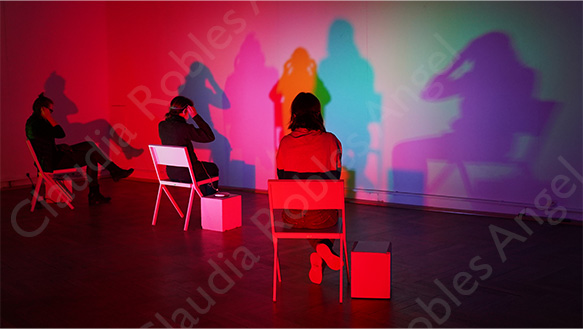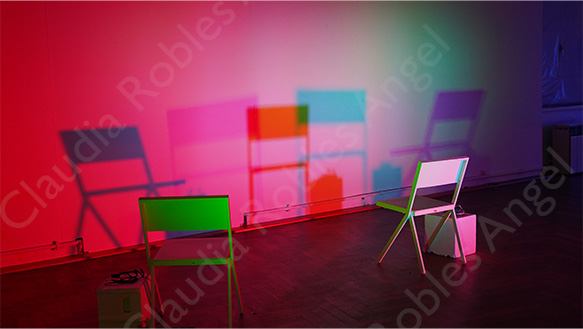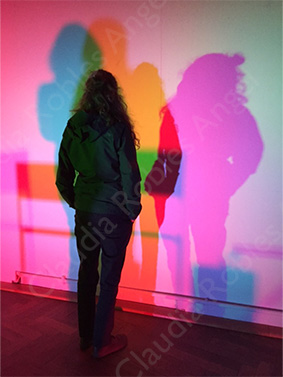
An interdisciplinary installation with sound and lighting by
Javier A. Garavaglia & Claudia Robles-Angel
The interdisciplinary installation BEETHOVENS GEIST (Beethoven’s Mind) invites guests to immerse themselves in a space made up of coloured shadows and a particular way of listening to its sound.
In addition, the installation takes Beethoven as a source of inspiration, whereby visitors experience Beethoven the citizen of Bonn, the sound artist, the humanist, the visionary, and the nature lover from the innermost parts of his mind. The following premises play a very important role here:
• That for Beethoven, the values of freedom, equality, and brotherhood were not only very deeply anchored in his life, but also in his music, because for him, life and art were completely intertwined according to humanistic values. His contemporaries also play a role in the installation (e.g. Goethe, with words and coloured shadows).
• Beethoven’s inner world and spirit, especially with regard to his deafness. The installation consists of two elements:
- an electroacoustic composition (fixed-media) listened to in the installation via bone-transmission headphones: https://icem.folkwang-uni.de/~gara/Media/BG_STEREO_MIX_5_200919_Master.mp3 GEMA
- Coloured shadows
The electroacoustic composition confronts visitors not only with Beethoven’s music and ideals but also with his way of dealing with such a situation as a deaf composer. Various aspects of Beethoven’s life can be experienced through audio, e.g. his music, the words of his contemporaries, etc. In addition to sections with his music, there are also walks in different locations where sometimes the outer surroundings can be heard, but sometimes only Beethoven in his inner self. Especially decisive in the piece are the words “Muss es sein? Es muss sein, es muss sein! ” (“Must it be? It must be, it must be!”) which Beethoven wrote on the score of his string quartet Opus 135 (Grave). While the reason why Beethoven added these words there is not entirely clear, they are used in various situations as a leitmotif with other musical excerpts of Beethoven’s work, leaving room for many different interpretations.
Although most of the musical quotations here are from Beethoven’s compositions, there are also excerpts from Haydn and Mozart that Beethoven certainly heard in his youth. For this purpose, quotes from Beethoven’s works are transformed with various sound effects that represent his hearing disorder. Furthermore, it is well known that Beethoven found a way to perceive sound, which his piano connected to his jawbone through a rod that he bit with his teeth. This procedure allowed the vibrations of the piano to be felt by his jaw bones, which is known as the principle of bone conduction.
As a result, the composition can only be listened to through special headphones that work on the principle of bone conduction. Also known as bone sound, bone conduction refers to the transmission of vibrations through the skull bone surrounding the hearing organ (near the middle ear), whereby the perception is masked by the signals transmitted as airborne sound due to the high sound wave resistance of the skull bone.
The piece is about 45 minutes long and consists of 19 sections composed in succession:
- (1) Introduction; (2) Promenade I; (3) Mozart, Haydn; (4) Promenade II: Bells, Water – Hearing Disorders I; (5) Goethe: Mephisto’s Flea (Goethe’s Poem, Lied by Beethoven); (6) Promenade III: Horse Cart – Hearing Disorders II; (7) Cello Sonata in A; (8) Promenade IV: Birds; (9) PASTORAL Symphony: II Movement – Scene by the Brook; (10) Must It Be? (11) Musical Creation I; (12) Promenade V: Birds (Filter); (13) An Die ferne Geliebte; (14) Promenade VI: Birds (Filter) II; (15) Musical Creation II: Filter; (16) Promenade VII: Hall/Filter/Horses/Delays; (17) Musical Creation III: Filter; (18) DEAFNESS: Low Frequencies; (19) Finale.
The coloured shadows in the room are inspired by Goethe’s Colour Theory (Beethoven’s contemporary), which is based on elementary and polar opposites of light and dark, which give the installation a unique colourfulness.


